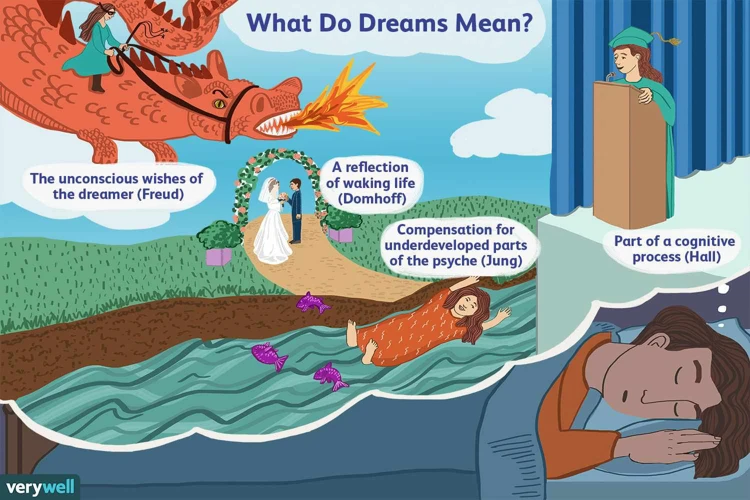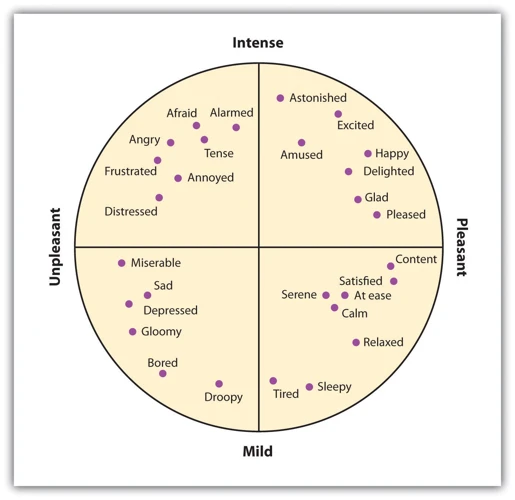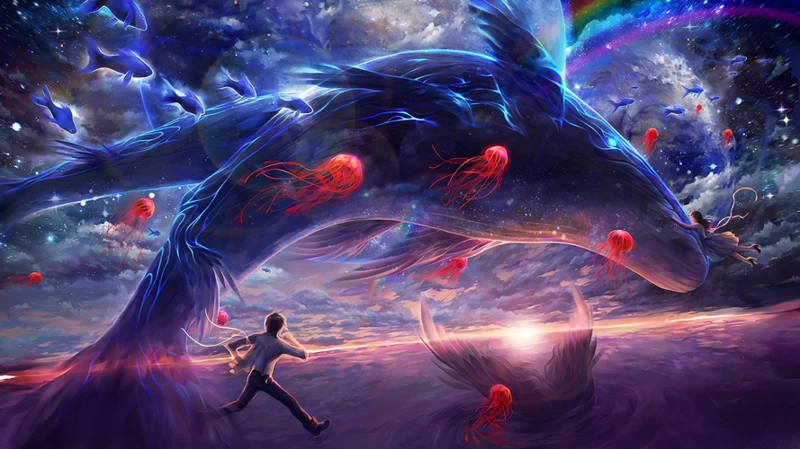Have you ever woken up from a dream feeling overwhelmed with emotion? Or perhaps you’ve had a dream that left you feeling anxious for the rest of the day. Dreams have long fascinated people, and the connection between our emotional state and our dream patterns has been the subject of much study and research. In this article, we will explore the science behind dreams and emotions, as well as the relationship between the two. We will examine common dream patterns related to emotions and offer tips for managing our emotional states for better sleep and personal growth. Let’s dive into the world of dreams and emotions together.
What are Dreams?

As we lay our heads down to rest each night, our minds embark on a journey that is both mysterious and intriguing. Our subconscious mind takes over, transporting us to another world where anything is possible. Dreams have fascinated humans for centuries, with ancient civilizations believing they held prophetic and spiritual meaning. Yet, what exactly are dreams and what purpose do they serve? Let’s delve into the intricacies of the dream world and explore the scientific theories behind this enigmatic phenomenon.
The Science Behind Dreams
Dreams have fascinated humans for centuries and have been the subject of numerous scientific studies. According to scientific research, during sleep, the brain passes through different stages, and each stage has a corresponding brain wave pattern.
| Stage | Brain Wave Pattern | Description |
| N1 | Theta Waves | The transition between wakefulness and sleep; light sleep |
| N2 | Sleep Spindles and K-Complexes | Deeper sleep; body functions start to slow down |
| N3 | Delta Waves | Deep sleep; difficult to awaken |
| REM | Fast, Low-Amplitude Brain Waves | Active brain with rapid eye movements; vivid dreaming |
During the REM stage, when the brain is highly active and there are rapid eye movements, people are most likely to have vivid dreams. This is because the amygdala, the part of the brain that processes emotions, is especially active during this stage. As a result, emotions that a person experienced during the day often find their way into their dreams, leading to dream content that is usually emotional in nature.
Research has found that dreams often reflect a person’s emotional state, personality, and daily experiences. These dreams may also help the brain process and consolidate memories, emotions, and experiences, providing a sort of “therapy” for the brain.
What is REM Sleep?
During REM sleep, our brain activity is high which usually results in vivid and memorable dreams. REM stands for Rapid Eye Movement, which is a phase of sleep where our eyes move quickly in different directions. Here are some key points to keep in mind about REM sleep:
- Duration: REM sleep typically starts about 90 minutes after falling asleep and can last up to an hour.
- Physical Changes: During REM sleep, our muscles become paralyzed to prevent us from acting out our dreams.
- Brain Activity: Our brain activity during REM sleep is similar to when we are awake, which is why dreams during this phase can be so vivid.
- Importance: While the exact purpose of dreaming is not fully understood, REM sleep is believed to play a role in memory consolidation and emotional regulation.
Understanding REM sleep is important because it helps us understand the biology behind our dreams and how they relate to our emotional state. By examining our dream patterns during different stages of sleep, we can gain a better understanding of the connection between our emotions and dreams.
What are Emotions?

Human beings are complex creatures with a range of experiences that often elicit strong feelings or reactions. These feelings are commonly known as emotions and can be described as a complex mix of psychological and physiological responses. Understanding emotions is key to understanding human behavior, and can have a significant impact on personal growth and development. In this section of the article, we will explore the purpose and different types of emotions that humans experience on a daily basis.
The Purpose of Emotions
Emotions are complex psychological experiences that are an intrinsic part of human life. They serve several important purposes, some of which are listed below:
- Survival: Emotions help humans to survive by alerting them to potential threats and danger in their environment. For instance, fear is a basic emotion that activates the fight or flight response, helping individuals to respond quickly to a dangerous situation.
- Communication: Emotions play an important role in interpersonal communication, and help individuals to express their thoughts and feelings to others. For example, happiness conveys a positive mood, while sadness may indicate a need for support or comfort.
- Motivation: Emotions can motivate individuals to take action towards achieving their goals. For instance, excitement can motivate an individual to pursue a new opportunity, while anger may motivate them to stand up for their rights.
- Memory: Emotions can enhance memory by serving as a type of marker for important events. For instance, someone may remember a particularly joyful event in their life more vividly than a mundane one because of the strong positive emotions associated with it.
- Self-awareness: Emotions help individuals to understand their own desires, goals, and values. By identifying the emotions they experience in response to various situations, individuals can gain insight into their own feelings and motivations.
Emotions serve important purposes in human life, helping individuals to survive, communicate, motivate themselves, remember, and understand themselves better.
Different Types of Emotions
Emotions are complex feeling states that are experienced by human beings. There are several different types of emotions, each with its own unique set of characteristics and origins.
Primary Emotions
Primary emotions are the basic emotions that are universally experienced and recognized across all cultures. These emotions are considered to be the building blocks of more complex emotions. Examples of primary emotions include joy, sadness, anger, fear, surprise, and disgust.
Secondary Emotions
Secondary emotions are more complex emotions that arise from the combination of primary emotions. They are often more difficult to recognize and interpret than primary emotions. Examples of secondary emotions include guilt, shame, envy, jealousy, and love.
Positive Emotions
Positive emotions are emotions that are generally associated with pleasant experiences or thoughts. They can be experienced as fleeting moments or long-lasting states. Examples of positive emotions include happiness, contentment, joy, pride, and excitement.
Negative Emotions
Negative emotions are emotions that are generally associated with unpleasant experiences or thoughts. They can be experienced as fleeting moments or long-lasting states. Examples of negative emotions include anger, sadness, fear, despair, and frustration.
Basic Emotions
Basic emotions are the most fundamental emotions that humans experience. They are thought to be biologically determined and genetically encoded. Examples of basic emotions include joy, anger, sadness, and fear.
Complex Emotions
Complex emotions are emotions that are more difficult to define and interpret than basic emotions. They are often influenced by contextual factors such as culture, social norms, and personal beliefs. Examples of complex emotions include nostalgia, schadenfreude, and cognitive dissonance.
Understanding the different types of emotions is important for understanding how emotions affect our behavior, thoughts, and dreams. By recognizing and understanding our emotions, we can learn to better manage them and improve our emotional well-being.
The Relationship Between Emotions and Dreams

Have you ever woken up feeling a certain way after a vivid dream? Maybe you were happy, sad, anxious, or fearful. It’s no secret that our emotions can have a strong impact on our dreams, and in turn, our dreams can affect our emotional state. But what is the connection between emotions and dreams? How do our emotions manifest in our dreams and what patterns can we observe? In this section, we’ll explore this fascinating relationship and shed some light on the science behind it.
How Emotions Affect Your Dreams
It is widely known that our emotions play a significant role in our daily lives. But did you know that they also affect our dreams? Research has shown that our emotional state can impact the content and frequency of our dreams. Here’s a breakdown of how different emotions can affect your dreams:
| Emotion | Effect on Dreams |
|---|---|
| Sadness | Often results in dreams that are more negative and intense. These dreams may feature feelings of loss or despair. |
| Stress | Frequently leads to dreams that are chaotic and unpredictable. Dreams may feature stressful situations or recurring events that cause anxiety. |
| Fear | May cause more nightmares or vivid dreams. These dreams may feature threats or danger. |
| Happiness | Can lead to dreams that are more positive and uplifting. Dreams may feature joyful experiences or success. |
| Love | May result in dreams that feature positive romantic experiences or strong emotional connections with others. |
Note: It’s important to keep in mind that everyone’s dream patterns and emotions are unique. While some emotions may impact dreams in general, others may not affect dreams as much for certain individuals. However, research has shown that a correlation between emotions and dream content does exist.
Common Dream Patterns Related to Emotions
Dreams can provide a glimpse into the emotional state of a person. Certain emotions can lead to specific dream patterns. Some common dream patterns related to emotions are:
| Emotion | Dream Pattern |
|---|---|
| Anxiety | Feeling lost or trapped; falling from a height; being chased; feeling unprepared for an event |
| Fear | Encountering dangerous animals or people; being in a life-threatening situation; experiencing a natural disaster |
| Anger | Feeling attacked or threatened by someone; fighting or arguing with someone; experiencing a sense of powerlessness |
| Sadness | Experiencing loss or grief; being separated from loved ones; feeling hopeless or helpless |
| Excitement | Experiencing positive events or accomplishments; meeting someone famous; exploring new places or ideas |
It is important to note that not everyone will experience the same dream patterns and emotions can manifest in different ways for different people. However, understanding these common patterns can provide insight into one’s emotional state and serve as a starting point for exploration and personal growth.
Why Understanding this Connection is Important
As we explore the connection between emotions and dreams, it’s essential to understand why this relationship holds significance. Understanding the impact of emotions on our dream patterns can lead to personal growth and development. Being able to manage our emotions and dreams effectively can also improve our overall mental and emotional well-being. Let us delve into some significant reasons behind the importance of comprehending this connection.
Personal Growth and Development
Exploring the connection between emotions and dream patterns can also lead to personal growth and development. Understanding your emotions and how they impact your dreams can provide valuable insights into your subconscious mind, helping you to identify and work through personal issues.
Self-Awareness: By recognizing the emotions present in your dreams, you can gain a better understanding of your own emotional states. This self-awareness can help you to identify areas where you may be struggling, such as unresolved conflicts or unexpressed feelings.
Problem-Solving: Dreams can often reveal underlying issues that you may not have been aware of. By examining your dreams and the emotions that accompany them, you can identify potential problems and begin to work on solutions.
Emotional Regulation: Learning to manage your emotions in waking life can also help to improve your dream patterns. By regulating your emotions, you may experience fewer nightmares or unpleasant dreams.
Mindfulness: Paying attention to your emotions and dream patterns can also cultivate mindfulness. By being present and aware of your thoughts and emotions, you can better understand yourself and learn to live in the moment.
To summarize, becoming more aware of the connection between emotions and dream patterns can lead to personal growth and development. By practicing self-awareness, problem-solving, emotional regulation, and mindfulness, you can work through personal issues and improve your overall well-being.
Tips for Managing Emotions and Dreams
Struggling with managing your emotions and dreams can be a challenging experience. Here are some useful tips that can help you manage your emotions and improve the quality of your dreams:
- Practice self-care: Self-care activities such as exercise, meditation or practicing mindfulness can help you relieve stress and anxiety that can affect the quality of your sleep and the emotional content of your dreams.
- Journal your dreams: Keep a journal by your bedside, and write down your dreams immediately after waking up. Documenting and analyzing your dreams may help you identify recurring patterns and gain self-awareness.
- Express your emotions: Instead of suppressing your emotions, you can try expressing them through writing, art, music or talking to a friend or therapist. Venting your emotions in a healthy way can help you prevent negative feelings from manifesting in your dreams.
- Create a bedtime routine: Having a consistent routine in the evening that can help you relax and prepare for sleep. This can include activities such as taking a warm bath, reading a book, or practicing deep breathing exercises.
- Avoid stimulants: Stimulants such as caffeine, alcohol, and nicotine can interfere with your sleep and cause vivid or disturbing dreams, so it is best to avoid consuming them especially before bedtime.
- Consult a professional: If you have frequent nightmares, recurring vivid dreams or experience intense emotions in your dreams, it is important to seek professional help. A therapist or counselor can help you manage your emotions and mental health effectively.
By managing your emotions and taking care of your mental health, you can improve the quality of your sleep and dreams, leading to positive benefits for your overall well-being.
Conclusion
In conclusion, the relationship between emotions and dream patterns is a complex and fascinating one. Our emotions and mental state can greatly impact the content and quality of our dreams. Understanding this connection is important for personal growth and development.
By being aware of our emotional state and managing it effectively, we can improve the overall quality of our dreams and gain insight into our subconscious mind. Recognizing common dream patterns related to our emotions can also help us identify and address any underlying issues.
It’s also important to note that while emotions can impact our dreams, the reverse is equally true. Our dreams can also have a significant impact on our emotional state, providing a channel for processing and resolving emotions that we may not have been consciously aware of.
Overall, by understanding the connection between emotions and dream patterns, we can gain a deeper understanding of ourselves and improve our emotional well-being. With the tips and techniques outlined in this article, you can start managing your emotions and dreams effectively and unlock the full potential of your subconscious mind.
Frequently Asked Questions
What is lucid dreaming?
Lucid dreaming is the ability to become aware that you are dreaming while you are still asleep. This can give you control over the dream and allow you to manipulate it in any way you desire.
Can emotions from real life affect your dreams?
Yes, emotions from real life can affect your dreams. This is because emotions play a crucial role in the formation and content of dreams.
What is the connection between nightmares and emotions?
Nightmares often occur when negative emotions, such as fear or anxiety, are experienced in waking life. These emotions can carry over into our dreams, resulting in unpleasant or terrifying nightmares.
Can dreams be used to process emotions?
Yes, dreams can be used as a tool to process emotions experienced in waking life. In fact, many people use dreaming as a way to work through difficult emotions and situations.
Is it possible to influence your dreams?
Yes, it is possible to influence your dreams through techniques such as lucid dreaming, visualization, and dream incubation. With these techniques, you can actively shape the content and direction of your dreams.
What is the purpose of nightmares?
The purpose of nightmares is still not completely understood, but they may serve as a way for the brain to process and work through strong negative emotions.
What causes recurring dreams?
Recurring dreams may be caused by unresolved emotions or unresolved issues in your waking life. They can also be caused by trauma or other significant life events.
How can dream journaling help with managing emotions?
By keeping a dream journal, you can become more aware of the emotions you are experiencing in your dreams. This can help you identify patterns and understand how your emotions are affecting your dreams and vice versa.
What is the relationship between stress and dreams?
Stress can often lead to more frequent and vivid dreams, sometimes resulting in nightmares. These dreams may also be more difficult to remember or process upon waking.
Can taking medication affect your dreams?
Yes, certain medications can affect the content and frequency of your dreams. This may be particularly true for medications that affect brain chemicals such as serotonin or dopamine.








